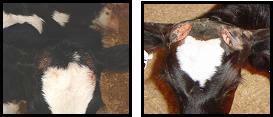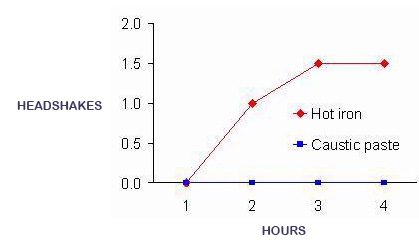Dan Weary
Dairy cattle are typically dehorned to reduce the risk of injuries to humans and other animals. To prevent horn growth, tissue is destroyed using a variety of methods including heat cauterization with a hot-iron and chemical cauterization with caustic paste. Choice of method has depended largely upon the producer’s experience and preference. Both methods require skill to use correctly, and misapplications can result in unintended injuries (Figure 1).

Figure 1. (A) Well-healed scabs after caustic paste dehorning (B) Over-application of caustic paste can damage the calf.
Both methods are also painful for the calf. Previous work by our research group and others has shown that during hot-iron dehorning calves experience distress associated with physical restraint, pain during the dehorning process, and post-operative pain during the hours that follow. Research has also shown this pain and distress can be decreased by use of a sedative, a nerve block or anti-inflammatory drugs.
Much less is known about pain associated with caustic paste dehorning. With caustic paste tissue damage continues as long as the active chemical is in contact with the tissue, so it cannot be assumed that the time course, pain response and pain treatment methods would be the same as for hot-iron dehorning. The aims of our study were to; 1) examine the time course of the pain in response to caustic paste dehorning, 2) examine methods of treating this pain, and 3) compare the calf’s responses to caustic paste with responses to hot-iron dehorning.
Holstein heifer calves between 10-35 days old were dehorned as part of two experiments. Experiment 1 examined the effects of using caustic paste and a sedative with and without a local anesthetic. In our procedure calves received 0.2 mg/kg of the sedative xylazine by intramuscular injection. Once sedation took effect the hair surrounding the horn bud was clipped. Half the calves then received 9 mL of the local anesthetic lidocaine by subcutaneous injection around the horn bud and 10 minutes later a thin film of caustic paste was applied to each horn bud surrounded by a ring of petroleum jelly to prevent the paste from spreading. Several days before the actual dehorning all calves acted as their own control in a “sham dehorning” procedure during which they received the identical treatment as they did during dehorning except petroleum jelly was used instead of caustic paste.
Experiment 2 compared the responses of calves to hot-iron dehorning with the sedative and local anesthetic (xylazine and lidocaine) versus caustic paste dehorning with the sedative only (xylazine). In both experiments calf behaviour was monitored for 12 hours following the dehorning. To measure the pain response we recorded the frequencies of behaviours such as head shaking and head rubbing.
We found that pain-related behaviours increased in calves that were; 1) dehorned with caustic paste versus those sham dehorned and 2) dehorned with a hot-iron versus those dehorned with caustic paste. These results indicate that dehorning with caustic paste causes pain but that the pain is less than that caused by dehorning with a hot-iron, even when using lidocaine (see Figure 2).

Figure 2. Calves dehorned with caustic paste and a sedative show less pain response than calves dehorned using a hot-iron with both a sedative and local block. Other behavioural measures (not shown) demonstrate the same response.
Interestingly there did not seem to be a benefit to using lidocaine with the caustic paste. This may be because the effect of lidocaine is inhibited by the low pH of the caustic paste. However, the sedative was very important – it eliminated the need for physical restraint during the procedure, and any associated distress, and also provides some pain relief.
In summary, caustic paste dehorning with an xylazine sedative provides a relatively simple procedure for dehorning calves with a minimum of pain. At the UBC Dairy Centre we follow the procedure outlined below. Producers are encouraged to work with their veterinarians to develop a method of dehorning and pain treatment that works well for their herd.
Example Procedure for Dehorning:
- 10 min before dehorning calves are sedated with xylazine (0.2 mg/kg IM).
- Hair is clipped around each horn bud, a thin film of caustic paste (2 cm diameter) is rubbed into the scalp until each horn bud is evenly coated, and a ring of petroleum jelly is applied around the paste to prevent spreading.
- Calves are allowed to rest sternally until recovered from sedation.
The results discussed in this report are a summary of a paper by K. Vickers, L. Niel, L. Kiehlbauch and Dan Weary (J. Dairy Sci. 88: 1454-1459). Special thanks to the staff of the UBC Dairy Education and Research Centre and to Nicole Fenwick for her help in preparing this research report. This research was funded by the Dairy Farmers of Canada, the BC Dairy Foundation, NSERC and the many others listed at the Animal Welfare Program.
